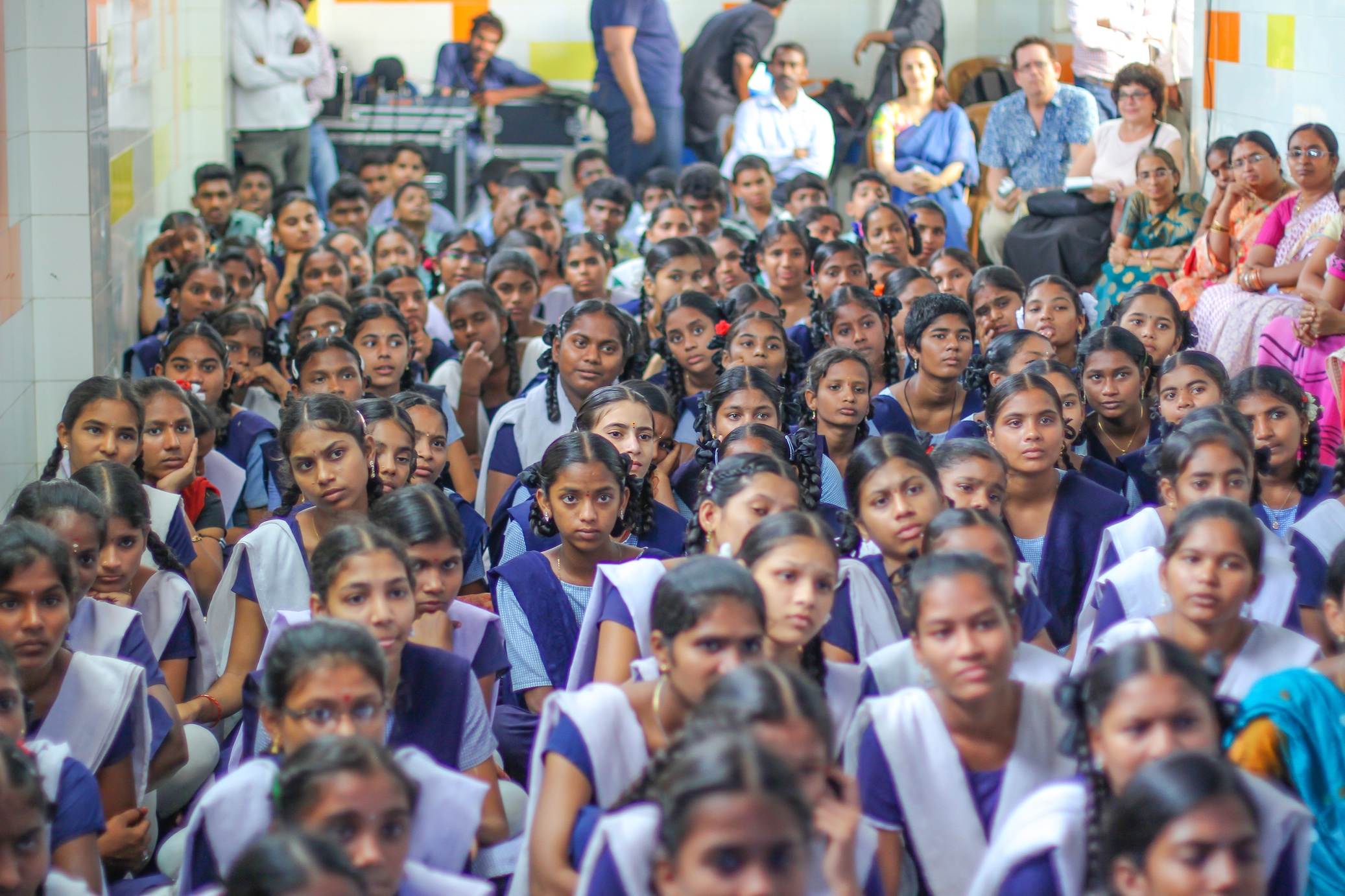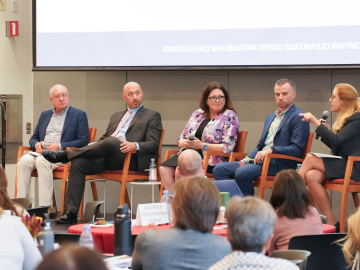

At Zilla Parishad High School in the south Indian metropolis of Hyderabad, more than 100 students in blue and white uniforms sit cross-legged on the stone floor, faces gleaming and eyes riveted on an animated video featuring Nagarjuna, a revered star of south Indian cinema.
The video with an avatar of the handsome, mustachioed actor doesn’t aim to entertain but to teach the students some basics about HIV/AIDS that could help protect their health and possibly save their lives.
“I never knew HIV existed,” one 13-year-old student, Dharana, said after viewing the 22-minute video. “I learned a lot. Now I have an awareness. I want to go to the hospital before marriage and have my groom get an HIV test.”
Though India has the third-highest number of AIDS cases in the world, knowledge about the disease is very low. Sex, the primary mode of HIV transmission, is a taboo subject, and there is no sex education in the schools, so students know precious little about a virus that has infected more than 2 million people in India, according to the United Nations Joint Programme on HIV/AIDS.
TeachAIDS, a nonprofit organization that began as a graduate student’s thesis project at Stanford, aims to fill that gap with culturally sensitive animated videos, as well as interactive versions for use on computers, that use the voices and faces of celebrity icons to teach the basics of HIV biology, how the virus is spread and how individuals can protect themselves.
Videos in 14 languages
Founded in 2009 by Stanford Graduate School of Education graduate Piya Sorcar, MA '06, PhD '09, the nonprofit now distributes its videos free of charge in more than 80 countries and in 14 languages. In India, the group plans to take the program national by the end of the year, distributing as many as 30,000 copies in each state where prevalence is high and providing versions in seven different languages, Sorcar said.
“I think what Piya has done is amazing,” said Douglas Owens, MD, professor of medicine, director of the Center for Primary Care and Outcomes Research/Center for Health Policy and adviser to the project. “Not only are the videos available in 81 countries but they are in countries where talking about these things has been taboo or very, very limited. And she’s done it in this very culturally sensitive, appropriate way. It’s really impressive.”
Each version is carefully tailored to the local culture, featuring recognizable local celebrities in local dress speaking local dialects.
The organization, supported by private philanthropy, donates the materials to governments, which then distribute them free of charge to schools, hospitals and counseling centers.
In 2012, the nonprofit was recognized in The Tech Awards, a signature program of The Tech Museum of Innovation in San Jose that honors large-scale initiatives using technology for philanthropic goals. It also has won the TR35 Award from MIT, which recognizes innovations that could have a dramatic impact on the world.
First launched in the hard-hit countries of sub-Saharan Africa, TeachAIDS began moving into India in 2009, at a time when the disease was rapidly spreading there.
“I was reading reports that India was to be a hot zone for HIV,” said Sorcar, an adjunct affiliate at the School of Medicine and lecturer in the Graduate School of Education, in a recent interview over coffee near her office in downtown Palo Alto. “Millions of dollars were poured into this problem, but knowledge levels were very low…. It was disturbing how much was unknown about the basics of transmission.”
On a visit to India that year, she managed to secure a five-minute interview with Nagarjuna, hoping he would agree to be featured in TeachAIDS productions. By sheer coincidence, Nagarjuna’s wife, actress and activist Amala Akkineni, had been embroiled just the week before in a heated public debate over the expulsion of HIV-positive students from the local schools in Hyderabad, India’s fourth-most populous city, with some 7 million people.
Though the AIDS virus cannot be transmitted through casual contact, uneducated parents were demanding that their children not sit side by side in class with children infected with the virus. Akkineni, herself a mother, managed to persuade the parents to back down from their demands by assuring them that the schools would introduce materials to educate the students about HIV.
Akkineni was at a loss; the government had banned previous HIV materials as pornographic, and some had been burned in public bonfires. She fretted about where to find AIDS information that officials would find acceptable. So Sorcar’s visit could not have been more auspicious: “My husband came home and said, ‘You have to meet this young lady, Piya Sorcar,’” Akkineni said. “It was cosmic.”
Within the year, TeachAIDS had released its first productions in the south Indian state of Andhra Pradesh, which has a population of more than 83 million and one of the highest rates of HIV in the country. Akkineni agreed to serve as trustee for the organization.
Star power
It was not Akkineni’s first foray into the epidemic. Once a major Bollywood actress, she had starred in 54 movies by the time she was in her mid-20s, but then decided to give up full-time acting to devote her time to social activism. An animal lover, she founded Blue Cross of Hyderabad, the city’s first and only animal shelter, in 1992.
Shortly after, she was approached by Karl Sequeira, an AIDS activist, who was looking to establish the city’s first AIDS hospice. It was a period in which people living with the disease were literally being wrapped up in blankets and tossed in the garbage, Akkineni said. Sequeira, who died in 2004, was moved by the dire need for humane care.
“I was already known as this notorious ex-actress who was running this hospice for animals,” Akkineni said in an interview in her office at the animal shelter. “So he thought I was a kindred soul.” In one evening, they raised 2.5 million rupees, about $40,000 in today’s currency, to start the project, among the wide-ranging HIV/AIDS and substance-abuse services provided now by Freedom Foundation.
The state of Andhra Pradesh had a crying need for such services; it claims the highest prevalence rate of AIDS in the country. A high rate of heterosexual sex outside of marriage, low condom use, a large migrant community and a flourishing sex-trafficking industry are among the factors that have contributed to spread of the virus, according to a report by the United Nations Development Program.
Akkineni said she is particularly concerned about sex trafficking, in which girls as young as 3 are sold into brothels, where they may contract HIV and serve as reservoirs for the virus.
To promote HIV prevention, TeachAIDS distributed 25,000 copies of the software for the videos throughout the state, and has shown the videos on private and government TV channels, Sorcar said. They target schools enrolling preadolescents and teenagers, reaching students at a vulnerable age (most girls marry between the ages of 18 and 20), with messages that are simple and clear.
“For the children, since it’s in animation format, it’s very attractive,” Basaveswara Rao, joint director of information, education and communication with the Telangana State AIDS Control Society, said during the airing of the video at Zilla Parishad High School. “Added to that are the celebrities, who deliver the message.”
TeachAIDS has recruited more than two dozen Indian celebrities to participate in the project, including Amitabh Bachchan. With his signature oversized glasses and renowned voice, he is one of the most influential actors in the history of Indian cinema.
In the Telugu-language version of the video, narrated by Nagarjuna, the actor tells the students that AIDS is a condition that does not have a cure, so it’s important to know how to prevent it.
Based on rigorous research and testing, the video provides the suggestion of human intimacy by showing a young couple together, then an image of birds kissing. A woman embracing a baby, her breast fully covered, conveys the concept of breastfeeding, one of the ways in which an HIV-positive mother can transmit the virus to her child.
One of the students, 14-year-old Priyanka, said after the video presentation that she had heard about HIV/AIDS before but didn’t really understand it. “Because it was a video, it caught my attention the whole time,” she said. “I feel everyone will benefit from this. The sooner you know you have HIV and get treatment, the better.”
Shirisha, a 16-year-old student, said: “I understood and was very happy because it’s about health, and I can learn how to protect myself and tell my family and friends.
Most parents are not educated and don’t know things. I want to take my groom before marriage for an HIV test” — a move that could save her life.
“The kids learn so much and you can see the joy in their eyes to receive these messages from their beloved role models,” Sorcar said. “The exciting part for our team is the palpable energy from the young people every time the software is shown in schools. It’s inspiring to see that using a research-based process matters — and it works.”
Subscribe to our monthly newsletter.
Stanford Graduate School of Education
482 Galvez Mall
Stanford, CA 94305-3096
Tel: (650) 723-2109
© Stanford University, Stanford, California 94305.



